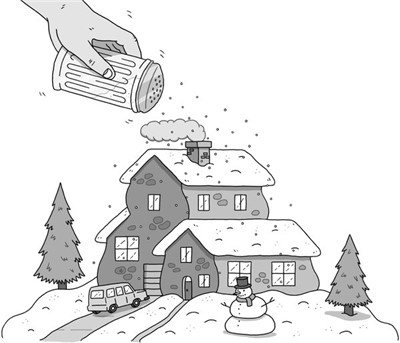YOUR co-worker brought in brownies, your daughter made cookies for a holiday party and candy is arriving from far-flung relatives. Sugar is everywhere. It is celebration, it is festivity, it is love.
同事带来了布朗尼,女儿为假期的聚会做了曲奇饼,八杆子打不着的亲戚也送来了糖果。到处都是糖。糖代表了庆祝,代表了节日,也代表了爱。
It’s also dangerous. In a recent study, we showed that sugar, perhaps more than salt, contributes to the development of cardiovascular disease. Evidence is growing, too, that eating too much sugar can lead to fatty liver disease, hypertension, Type 2 diabetes, obesity and kidney disease.
但糖也是一种危险。在最近的一项研究中,我们证明了糖分对心血管疾病的发展有推动作用,而且其影响或许比盐分更大。也有越来越多的证据表明,吃太多糖会引发脂肪肝、高血压、二型糖尿病、肥胖症和肾病。

然而人们无法抗拒。原因也相当简单,糖分是有成瘾性的。我们所说的「成瘾」并不是人们谈论美味时的那种意思,而是实实在在的,像毒品一样的成瘾性。而且食品工业正在竭尽所能,试图把我们勾住。
Up until just a few hundred years ago, concentrated sugars were essentially absent from the human diet — besides, perhaps, the fortuitous find of small quantities of wild honey. Sugar would have been a rare source of energy in the environment, and strong cravings for it would have benefited human survival. Sugar cravings would have prompted searches for sweet foods, the kind that help us layer on fat and store energy for times of scarcity.
直 到几百年前,浓缩糖实际上在人类的饮食中还不存在,除非偶然间找到少量野生蜂蜜。糖分在环境中是一种罕见的能量来源,对其产生强烈的渴望,对于人类的生存 是有利的。对糖分的渴求会促使我们寻找甜味的食物,也就是帮助我们堆积脂肪、积蓄能量,以备匮乏时期的那种食物。
Today added sugar is everywhere, used in approximately 75 percent of packaged foods purchased in the United States. The average American consumes anywhere from a quarter to a half pound of sugar a day. If you consider that the added sugar in a single can of soda might be more than most people would have consumed in an entire year, just a few hundred years ago, you get a sense of how dramatically our environment has changed. The sweet craving that once offered a survival advantage now works against us.
今 天,添加的糖分随处可见,在美国买到的包装食品中,有大约75%含有添加糖分。普通的美国人平均每天消耗的糖分在四分之一磅到半磅(约合110克至220 克)之间。如果我们思考一下,今天一听碳酸饮料里含有的添加糖分,可能高于几百年前多数人一整年消耗的糖分,就能明白我们周围的环境发生了多么巨大的改 变。渴求糖分曾经是我们的生存优势,但现在却对我们不利。
Whereas natural sugar sources like whole fruits and vegetables are generally not very concentrated because the sweetness is buffered by water, fiber and other constituents, modern industrial sugar sources are unnaturally potent and quickly provide a big hit. Natural whole foods like beets are stripped of their water, fiber, vitamins, minerals and all other beneficial components to produce purified sweetness. All that’s left are pure, white, sugary crystals.
天 然的糖分来源,如完整的水果和蔬菜,糖分浓度通常并不高,因为其中的甜味有水分、纤维和其他成分来缓冲。然而现代工业生产的糖分来源,却浓重得不自然,很 快就能提供巨大的冲击。就说甜菜这样的天然完整食品,其水分、纤维、维生素、矿物质,乃至其他所有有益成分都被剥离,用来生产纯化的糖。剩下的就只有白色 的、纯粹的糖晶体。
A comparison to drugs would not be misplaced here. Similar refinement processes transform other plants like poppies and coca into heroin and cocaine. Refined sugars also affect people’s bodies and brains.
在这里与毒品相提并论并不过分。将其他植物,如罂粟和古柯转变为海洛因和可卡因的提纯过程,与上述程序是相似的。纯化的糖分也会影响人的身体和大脑。
Substance use disorders, defined by the Diagnostic and Statistical Manual of Mental Disorders, exist when at least two to three symptoms from a list of 11 are present. In animal models, sugar produces at least three symptoms consistent with substance abuse and dependence: cravings, tolerance and withdrawal. Other druglike properties of sugar include (but are not limited to) cross-sensitization, cross-tolerance, cross-dependence, reward, opioid effects and other neurochemical changes in the brain. In animal studies, animals experience sugar like a drug and can become sugar-addicted. One study has shown that if given the choice, rats will choose sugar over cocaine in lab settings because the reward is greater; the “high” is more pleasurable.
按 照《精神障碍诊断与统计手册》(Diagnostic and Statistical Manual of Mental Disorders)的定 义,列明的11项症状中存在至少两到三种,就构成了物质使用障碍。在动物模型中,糖分至少产生了三种与物质滥用和依赖相吻合的症状:渴求感、耐受性、戒断 症状。糖分其他与毒品相似的特性还包括(但不限于)交叉敏化、交叉耐受性、交叉依赖性、奖赏效应、阿片效应,以及大脑中的其他神经化学变化。在动物实验 中,动物对糖的感受就像一种毒品,而且可能会对糖产生依赖。一项研究显示,如果提供了选择,大鼠在实验室的环境中会选择糖而不是可卡因,因为前者的奖赏效 应更强,即糖带来的「兴奋感」有着更高的愉悦度。
In humans, the situation may not be very different. Sugar stimulates brain pathways just as an opioid would, and sugar has been found to be habit-forming in people. Cravings induced by sugar are comparable to those induced by addictive drugs like cocaine and nicotine. And although other food components may also be pleasurable, sugar may be uniquely addictive in the food world. For instance, functional M.R.I. tests involving milkshakes demonstrate that it’s the sugar, not the fat, that people crave. Sugar is added to foods by an industry whose goal is to engineer products to be as irresistible and addictive as possible. How can we kick this habit? One route is to make foods and drinks with added sugar more expensive, through higher taxes. Another would be to remove sugar-sweetened beverages from places like schools and hospitals or to regulate sugar-added products just as we do alcohol and tobacco, for instance, by putting restrictions on advertising and by slapping on warning labels.
对 于人类,这些情况可能也并没有多大不同。就像鸦片类物质一样,糖分也会刺激大脑回路,而研究发现,糖分会影响人类习惯的形成。糖分产生的渴求感与可卡因和 尼古丁等成瘾性物质所产生的渴求感可以相提并论。而尽管其他的食品成分也会让人愉悦,但是在食品当中,糖分可能具有独一无二的成瘾性。例如,对饮用奶昔的 人进行的功能性磁共振成像(fMRI)检测显示,让人产生渴望的是糖分,而不是脂肪。食品企业在食品中加入糖分,目的是调整产品成分,使其尽可能地难以抗 拒、成瘾性尽可能地强。我们怎么才能戒除这个习惯?一种途径是通过提高税收,让含有添加糖分的食品或饮料更昂贵。另一种途径则是要求学校、医院等地,停止 提供加糖增甜饮品,或者像监管烟酒一样监管添加糖分的产品,例如对广告加以限制,或者加注警示提醒。
But as we suggested in two academic papers, one on salt and sugar in the journal Open Heart and the other on sugar and calories in Public Health Nutrition, focusing narrowly on added sugar could have unintended consequences. It could prompt the food industry to inject something equally or more harmful into processed foods, as an alternative.
但 就像我们在两篇论文——一篇发表在《开放心脏病学》(Open Heart)上,主题是盐和糖,另一篇发表在《公共健康营养学》 (Public Health Nutrition)上,主题是糖分和卡路里——里提出的,只是狭隘地关注添加糖分可能会产生始料未及的后果。这样做可能 会促使企业在加工食品中,加入同样有害,甚至危害更大的其他物质作为替代。
A better approach to sugar rehab is to promote the consumption of whole, natural foods. Substituting whole foods for sweet industrial concoctions may be a hard sell, but in the face of an industry that is exploiting our biological nature to keep us addicted, it may be the best solution for those who need that sugar fix.
摆脱糖分的更好途径是,推广食用未经加工的天然食品。用完整的天然食品替代工业生产的甜食,或许很难让人接受,然而面对这样一个利用我们的生物天性让我们成瘾的产业,这对那些渴求糖分摄入的人,或许是最好的方法。












